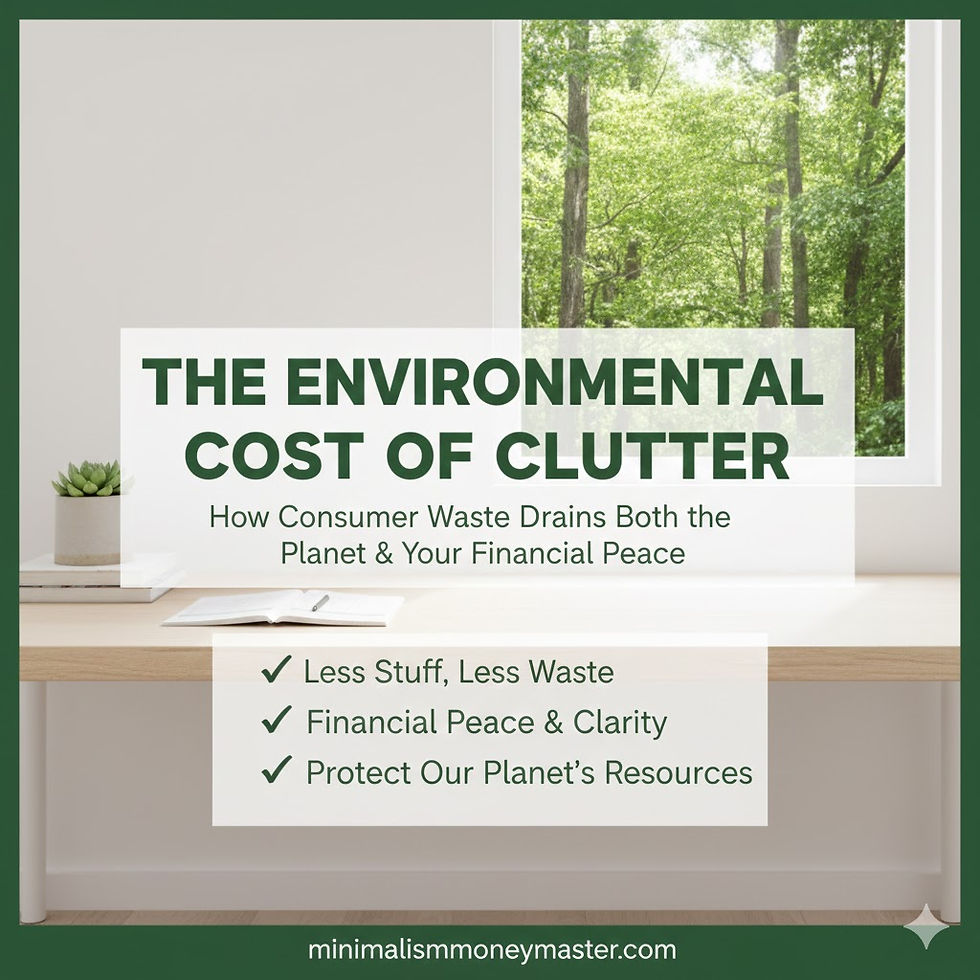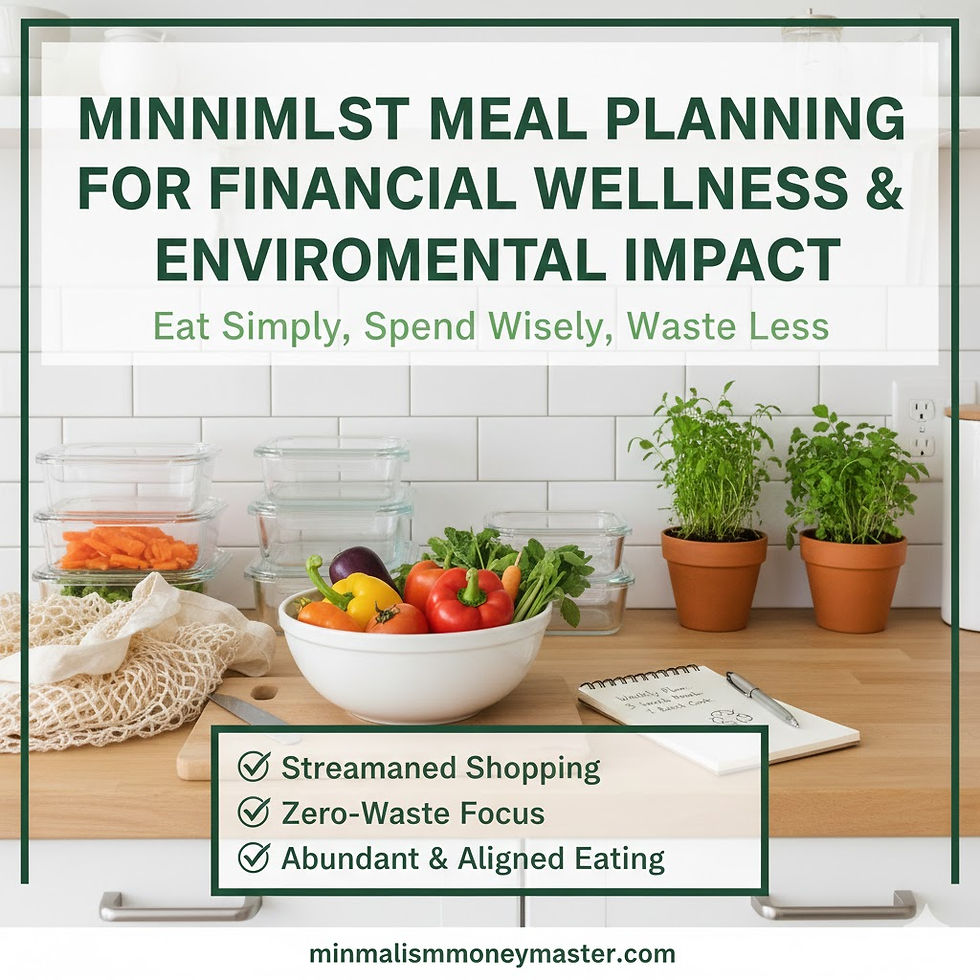What to Do If You Can’t Pay Your Credit Card Bill: A Minimalist Finance Guide
- jennifercorkum
- Sep 6
- 4 min read
Navigating financial challenges is tough. Few situations feel more overwhelming than realizing you can’t pay your credit card bill. The stress can be paralyzing — but ignoring the problem only makes it worse. By applying minimalist financial principles, you can take back control, simplify your money habits, and create a sustainable path out of debt.
This guide will walk you through how to handle missed credit card payments, practical debt solutions, and steps to rebuild a resilient financial foundation.

Understanding the Consequences of Missing a Payment
Before diving into solutions, you need to understand what happens when you miss a credit card payment. This isn’t about fear — it’s about awareness. Knowing the stakes helps you act quickly and intentionally.
Immediate Consequences
Late Fees: Credit card companies typically charge a flat late fee as soon as you miss a due date. For someone on a tight budget, this adds unnecessary strain.
Higher Interest Charges: Missed payments often trigger penalty APRs — higher interest rates that make debt snowball faster. With average credit card APRs hovering above 20%, every delay gets expensive.
Long-Term Impact
Credit Score Damage: After 30 days, your missed payment is reported to credit bureaus. Your score can drop by up to 80 points, making it harder to secure loans, rent apartments, or even get certain jobs.
Charge-Offs and Collections: After about 180 days, your debt could be sold to collectors. This leaves a black mark on your credit report for up to seven years.
The takeaway? Act fast. Every day matters when it comes to credit card debt.
Step 1: Stop the Bleeding
Minimalist finance starts with cutting off financial leaks. Stop using your credit card immediately.
Remove it from your wallet and digital payment apps.
Pause non-essential subscriptions and auto-payments tied to it.
Avoid "just one more purchase" thinking — that's how debt spirals.
By freezing spending, you create a stable starting point for recovery.
Step 2: Make the Minimum Payment (If You Can)
If possible, pay at least the minimum due. While it won’t eliminate your debt, it prevents:
Late fees
Credit score hits from 30-day delinquencies
Higher penalty APRs
Think of this as buying yourself time to strategize without compounding the problem.
Step 3: Call Your Credit Card Company
Most people avoid this step out of fear — but creditors often want to work with you. Call your card issuer, explain your situation calmly, and ask about relief options:
Waive Late Fees: If it’s your first missed payment, many issuers will waive them.
Temporary Hardship Programs: Some offer reduced interest rates or paused payments for a few months.
Lower Minimum Payments: You might negotiate short-term breathing room.
Minimalist finance teaches us to communicate openly and simplify. This is one conversation worth having.
Step 4: Explore Debt Management Solutions
If your financial situation is long-term, structured solutions may be necessary.
1. Credit Counseling
Nonprofit credit counseling agencies help you:
Create a realistic budget
Understand your debt landscape
Set up a Debt Management Plan (DMP), making one consolidated payment to the agency, which negotiates with creditors for lower rates.
This approach aligns with minimalist principles: streamline your obligations into one manageable payment.
2. Debt Consolidation
Debt consolidation combines multiple balances into one loan — ideally at a lower interest rate.
Balance Transfer Cards: Some cards offer 0% APR introductory periods for 12–21 months.
Personal Loans: If your credit allows, a fixed-rate personal loan can reduce your interest burden.
⚠️ Caution: Consolidation is a tool, not a cure. It works only if you commit to repayment and avoid creating new debt.
3. Avoid Debt Settlement Scams
Be skeptical of for-profit debt settlement companies. While they promise to negotiate reduced balances, risks include:
High fees eating up savings
Credit damage from stopping payments
No guarantees creditors will agree
Minimalist finance thrives on intentional, low-risk strategies — avoid shortcuts that create new problems.
Step 5: Build a Minimalist Financial Recovery Plan
Once you’ve stabilized your situation, it’s time to rebuild — intentionally and sustainably.
1. Focus on High-Interest Debt First
Use one of these repayment strategies:
Debt Avalanche (Minimalist Favorite): Pay off debts with the highest interest first. This saves the most money long-term.
Debt Snowball: Start with the smallest balances for quick wins and momentum.
Whichever method you choose, stick to it consistently.
2. Create an Emergency Fund
One key minimalist principle: buffer against uncertainty.
Start small — aim for $1,000 to handle surprise expenses.
Then, build toward 3–6 months of essential living costs.
An emergency fund keeps you from falling back into the credit card trap when life happens.
3. Live Below Your Means
A minimalist lifestyle isn’t about deprivation — it’s about intentional spending:
If you can’t pay cash today, you can’t afford it.
Reduce clutter — financial and physical.
Prioritize experiences and freedom over possessions.
When your lifestyle costs less than your income, you automatically gain breathing room.
4. Create a Simple Financial Plan
Set clear, minimalist goals:
Pay off credit card debt entirely
Build and maintain an emergency fund
Save for your future — retirement, experiences, or security
Track every dollar. Be intentional with every choice.
Final Thoughts: Minimalism Is Your Path to Freedom
When you can’t pay your credit card bill, it’s easy to spiral into stress and fear. But adopting a minimalist financial mindset can change everything:
Simplify your spending habits
Prioritize what truly matters
Rebuild with intention and clarity
Credit card debt isn’t just a financial problem — it’s a signal to rethink your relationship with money. By cutting excess, focusing on essentials, and living intentionally, you can escape the cycle and build lasting financial freedom.







Comments